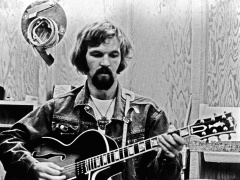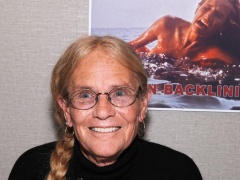
Jerry Moss, who turned A&M Records into one of America’s leading independent record labels with his business partner Herb Alpert, died Wednesday in Los Angeles. He was 88.
“They truly don’t make them like him anymore and we will miss conversations with him about everything under the sun. The twinkle in his eyes as he approached every moment ready for the next adventure,” his family said in a statement to the Associated Press.
In recent years, Moss had focused his efforts on philanthropy, including a 2020 gift of $25 million from the mogul and his wife Tina Morse to L.A.’s Music Center that resulted in the complex’s outdoor plaza being renamed after him. His last public event, in January of this year, found him being feted by the Music Center with a tribute concert at the Mark Taper Forum, where Alpert spoke, David Foster hosted and Peter Frampton, Amy Grant and Dionne Warwick all serenaded the guest of honor.
“Jerry was dedicated to giving back to the community by supporting arts experiences that resonate in the hearts and minds of all Angelenos and meaningfully impact their lives,” said Rachel S. Moore, president-CEO of the Music Center. “His artistic influence and business savvy, along with the opportunities he provided for numerous extraordinarily talented artists, changed the course of music forever. That was his gift to us all. We offer our heartfelt sympathies to Tina and the entire Moss family.”
Moss had also reentered the public eye in recent years with a popular documentary, “Mr. A & Mr. M: The Story of A&M Records,” that aired in two parts on Epix at the end of 2021.
A&M rose to prominence during the 1960s behind huge pop hits by trumpeter Alpert’s band the Tijuana Brass, whose worldwide sales are estimated in excess of 70 million albums.
After entering the rock business at Moss’ insistence in the late ’60s, the label witnessed booming sales during the ’70s and ’80s with such talent as Supertramp, Peter Frampton, the Police, the Go-Go’s, Bryan Adams and Janet Jackson.
Following the sale of A&M to Polygram in 1989, Moss and Alpert founded a new imprint, Almo Sounds, which developed such acts as Garbage and Ozomatli.
Moss and Alpert were inducted into the Rock and Roll Hall of Fame as non-performers in 2006.
Born in Brooklyn and educated at Brooklyn College, Moss entered the record business after a chance meeting at a wedding with Coed Records partner Marvin Cane led to a job doing radio promotion for the label. Moss was instrumental in the success of the Crests’ doo-wop hit “16 Candles,” a No. 2 single for the New York indie in 1958.
After a year and a half with Coed, Moss relocated to Los Angeles, where he started up his own independent record promotion firm. Work as a record producer brought him into contact with Alpert, who had been writing and producing in partnership with Lou Adler; the team split, with Alpert claiming a two-track Ampex tape machine in the dissolution.
Moss, a jazz fan, admired Alpert’s instrumental talent, and the pair began a label venture to showcase it. Dubbed Carnival Records, the imprint began life with a vocal single, “Tell It to the Birds,” credited to “Dory Alpert” in 1962.
The number became a local hit, and a distribution deal with Dot Records (arranged by L.A. disc jockey and record man Wink Martindale) brought the infant label some operating capital. However, potential conflict over ownership of the Carnival name led the partners to rechristen their company with the initials of their last names, A&M.
At that point, the label was operating humbly out of Alpert’s Hollywood garage. “[Alpert] had a piano, the two-track tape recorder, and I had a desk with the phone, with two extensions,” Moss recalled in a 2007 interview.
It was in that garage that Alpert and Moss recorded the single that would supply A&M with national liftoff. The partners were both bullfight fans; inspired by Nashville bassist Bob Moore’s 1961 hit “Mexico,” Alpert cut a mariachi-flavored version of a Sol Lake composition, embellished by crowd noises recorded at a Tijuana bull ring.
The resultant single, “The Lonely Bull,” climbed to No. 6 on the national singles chart in 1962, selling an estimated 750,000 copies.
It took several years for A&M to secure another hit of that magnitude; in the interim, the company maintained a profile by releasing pop singles like Chris Montez’s “Call Me” and “The More I See You” and signing developing talent like Buddy Holly’s former sideman Waylon Jennings (who ultimately departed A&M for a superstar country career at RCA).
Alpert’s music career ultimately caught fire in 1965; in the space of three years, the trumpeter racked up six No. 1 albums and two more top-five LPs. Such like-minded A&M acts as the Baja Marimba Band (led by Alpert’s band member Julius Wechter) and Sergio Mendes (signed after he was dropped by RCA) also scaled the charts. Moss later claimed that in 1966 – the year the company moved into Charlie Chaplin’s old studio lot on La Brea Avenue in Hollywood — A&M outsold the Beatles in America, shifting 13 million albums.
While A&M was firmly entrenched in the pop market of the day, it had been untouched by the roiling revolution in rock music. Moss was intrigued by the new sounds, and attended the Monterey Pop Festival in June 1967.
“I heard all this great rock music,” he said later, “and I felt embarrassed and upset because we didn’t have any, and I decided we needed to get some.”
Alpert himself gave Moss the credit for the move toward rock ‘n’ roll in a 2021 PvNew interview. “Jerry sparked it,” Alpert said. “He said, ‘Man, we’re kind of known as an easy listening label.’”
Though A&M could still reliably promote such pop acts as the mega-selling brother-and-sister duo the Carpenters, the label also signed a provocative slate of rock talent, including country-rock pioneers the Flying Burrito Brothers, avant-rocker Captain Beefheart, Jethro Tull spinoff Blodwyn Pig, bluesy Brit vocalist Joe Cocker and former Byrds member Gene Clark.
It wasn’t until the ’70s that A&M scored its biggest rock hits with albums by English rock unit Humble Pie, guitarist-singer Frampton (whose 1976 two-LP concert set “Frampton Comes Alive!” was one of the decade’s biggest sellers) and British group Supertramp(whose “Breakfast in America” ruled the charts in 1979). The company also released an evergreen album, Carole King’s 1971 smash “Tapestry,” via a distribution deal with Ode Records, operated by Alpert’s former partner Lou Adler.
The immense success of artists like the Police, the Go-Go’s and Janet Jackson powered A&M into the ’80s. However, as bidding for the services of name artists escalated, Alpert and Moss came to believe that they couldn’t compete in the marketplace, and they sold their label to Philips Electronics’ record division Polygram, which was then distributing the company’s product, for an estimated $500 million.
“Oh, at the time, we had to do that,” Moss told PvNew in a 2021 interview. “It was predicated on different things that at the time were important, such as signing bonuses certain artists received. We just couldn’t match those. And we thought we needed the help of another label to do that. Polygram had been helpful before. But they were not helpful afterwards.”
The partners remained on board in an executive capacity, but conflict with Polygram’s senior management led them to ankle the firm in 1993.
The following year, Moss was diagnosed with prostate cancer. He successfully battled the disease, and emerged from the crisis hankering for a return to the business.
Thus, Alpert and Moss founded a boutique imprint, Almo Sounds, which was headquartered in modest offices next door to a La Cienega Boulevard strip joint. The company enjoyed modest success with its alternative-leaning roster, and also released three albums by Alpert before the company ceased operations in 2000.
In later years, Moss and his second wife, Ann, focused their attention on breeding and racing thoroughbred horses. In 2005, their stallion Giacomo won the Kentucky Derby, collecting a $1.6 million purse.
At the Music Center tribute in January, Sting contributed a pre-recorded speech in which he talked about the horse racing affinity, noting hewas gratified “by the fact that you named some of your best horses” after Police recordings — including a champion named Zenyatta — or, in at least one famous case, Police offspring. “You named Giacomo after my third son, and he won the Kentucky Darby as a rank outsider,” Sting recalled. “Trudie (Styler) and I put a thousand dollars on that horse, and we’re still living on the takings.”
After Moss and his wife Ann announced their divorce in 2017, he went on to wed Tina Morse in 2019, and they made news together with their significant endowment to the Music Center.
The Mark Taper tribute had the Music Center’s Moore singing Moss’ praises. “Tina and Jerry have joined our quest to innovate for future generations and support our vision to deepen the cultural lives of all Angelenos all year long and all over L.A. County,” she said. “Tens of thousands of people enjoy free and low-cost experiences on Jerry Moss Plaza and in Grand Park. Over 150,000 students and their families experience the learning programs in schools and neighborhoods. And through our Spotlight program… we provide opportunities for artistic and career development, mentorship and scholarships to more than 1400 young adults every year.”
Moss did not speak at January’s tribute event, but Alpert paid his partner a lengthy testimonial.
“I don’t think I would’ve had the musical career that I’ve had without Jerry Moss. I knew how to make records, but I didn’t know what to do with them. Jerry did. He sure did,” said Alpert, putting his weight behind the notion that Moss was by far the more business-minded of the two.
“Jerry and I never, ever signed an agreement or contract together with each other,” Alpert added. “We didn’t have a (contract) that we were legally partners. Am I right, Jerry? It was unbelievable. We took this company from two people to 500 people, and I never had a (written) agreement with Jerry because I trusted him and Jerry trusted me. When we sold the company, that was the first time we put our names down on a contract, that we were agreeing to this sale. … I got lucky to have a partner and a dear friend like Jerry Moss. Jerry’s an unforgettable person, because he’s real… I adore you, man.”
Other areas of philanthropy included establishing the Moss Scholars program at UCLA, which since 2004 has provided full scholarships to dozens of graduate and undergraduate students in art, architecture and music. Also at UCLA, in the area of health care, he endowed the Moss Foundation Chair in Gastrointestinal and Personalized Surgery and supported the Voice Center for Medicine and Department of Neurosurgery. He was a major donor to California CareForce, providing no-cost treatment and healthcare clinics throughout California. And he was a supporter of the Geffen Playhouse (of which he was a founding trustee), the ACLU, the Exceptional Children’s Foundation, the Hammer Museum, KCRW, Painted Turtle Camp, People for the American Way and Young Eisner Scholars.
Moss’ survivors include Tina Morse, his third wife, and three children he adopted with his first wife, Helen Sandra Rusetos.
Additional reporting by Chris Willman






